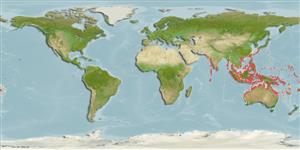>
Eupercaria/misc (Various families in series Eupercaria) >
Nemipteridae (Threadfin breams, Whiptail breams)
Etymology: Scolopsis: Greek, skolex = worm + Greek, opsis = appearance (Ref. 45335).
More on author: Bloch.
Environment: milieu / climate zone / depth range / distribution range
นิเวศวิทยา
เกี่ยวกับทะเล,น้ำเค็ม เกี่ยวกับหินโสโครก; ระดับความลึก 1 - 25 m (Ref. 9710). Tropical; 32°N - 36°S, 66°E - 172°W (Ref. 3810)
Indo-West Pacific: Maldives (Ref. 11303) and the Laccadive Islands to Fiji, north to southern Japan, south to Lord Howe Island. Recently reported from Tonga (Ref. 37816).
ขนาด / น้ำหนัก / Age
Maturity: Lm ? range ? - ? cm
Max length : 25.0 cm TL เพศผู้/กระเทย; (Ref. 90102); common length : 13.0 cm SL เพศผู้/กระเทย; (Ref. 3810)
เงี่ยงครีบหลัง (รวม): 10; ก้านครีบอ่อนที่หาง (รวม): 9; เงี่ยงครีบก้น 3; ก้านครีบอ่อนที่ก้น: 7. This species is distinguished by the following characters: head scales reaching to or just in front of anterior nostrils; lateral line scales 43-47 (usually 45-46); pectoral fin rays 16-18 (usually 17); snout length less than eye diameter; greatest body depth 2.5-3.0 in SL. Colour dark grey on head and back with diagonal black-edged white band separating dark area from the rest of the mainly whitish body; white blotch below posterior dorsal fin; 3 yellow stripes on upper head; juveniles with alternating black and yellow stripes on the upper half and whitish below, Batesian mimic of the poison-fanged blenny Meiacanthus grammistes (Ref. 90102).
Common on coral reefs. Adults occur on most reef habitats, usually in pairs, and juveniles inshore or in lagoons or rubble zones (Ref. 48635). Occurs singly or in small aggregations. Feeds on small fishes and benthic invertebrates. A protogynous hermaphrodite (Ref. 9785). Juvenile mimics poison-fanged blenny Miacanthus grammistes, Batesian mimic (Ref. 90102). Caught mainly by handline and live specimens captured by hand net for the aquarium export trade; no major fishery exists (Ref. 9785). It is parasitised by the monogenean Anoplodiscus hutsonae on the pectoral fins and body surface (Ref. 124057).
Life cycle and mating behavior
วัยเจริญพันธุ์ | การสืบพันธุ์ | การวางไข่ | เซลสืบพันธ์ของเพศเมีย(ไข่) | ความดกของไข่ | ตัวอ่อน
Russell, B.C., 1990. FAO Species Catalogue. Vol. 12. Nemipterid fishes of the world. (Threadfin breams, whiptail breams, monocle breams, dwarf monocle breams, and coral breams). Family Nemipteridae. An annotated and illustrated catalogue of nemipterid species known to date. FAO Fish. Synop. 125(12):149p. Rome: FAO. (Ref. 3810)
IUCN Red List Status (Ref. 130435)
Threat to humans
Harmless
Human uses
การประมง: การประมงยังชีพ; สถานที่แสดงสัตว์และพืชน้ำ: การค้า
ข้อมูลเพิ่มเติม
อ้างอิงการเพาะเลี้ยงสัตว์น้ำประวัติการเพาะเลี้ยงสัตว์น้ำสายพันธุ์พันธุศาสตร์ElectrophoresesอัตราพันธุกรรมโรคการแปรรูปNutrientsMass conversion
เครื่องมือ
Special reports
Download XML
แหล่งที่มาจากอินเตอร์เน็ต
Estimates based on models
Preferred temperature (Ref.
123201): 25.1 - 29.3, mean 28.6 °C (based on 2688 cells).
Phylogenetic diversity index (Ref.
82804): PD
50 = 0.5000 [Uniqueness, from 0.5 = low to 2.0 = high].
Bayesian length-weight: a=0.01380 (0.00863 - 0.02207), b=3.06 (2.93 - 3.19), in cm total length, based on LWR estimates for this species & Genus-body shape (Ref.
93245).
ระดับชั้นอาหาร (Ref.
69278): 3.6 ±0.50 se; based on food items.
ความสามารถในการกลับคืนสู่ปกติ (Ref.
120179): ความสูง, เวลาต่ำสุดที่จะทำให้ประชากรเพิ่มขึ้นเป็น 2 เท่าใช้เวลาน้อยกว่า 15 เดือน (Preliminary K or Fecundity.).
Fishing Vulnerability (Ref.
59153): Low vulnerability (15 of 100).
Nutrients (Ref.
124155): Calcium = 63.4 [39.7, 131.5] mg/100g; Iron = 0.68 [0.33, 1.65] mg/100g; Protein = 19.1 [17.2, 20.8] %; Omega3 = 0.146 [0.088, 0.244] g/100g; Selenium = 25.8 [15.1, 46.7] μg/100g; VitaminA = 80 [23, 234] μg/100g; Zinc = 1.32 [0.91, 1.91] mg/100g (wet weight);
